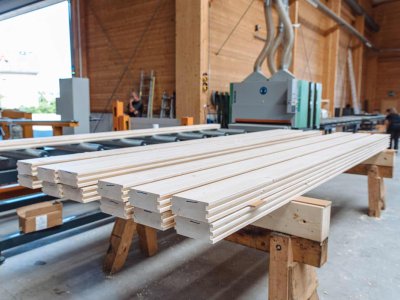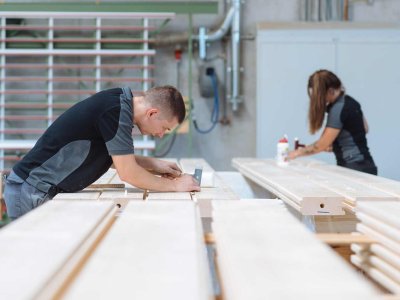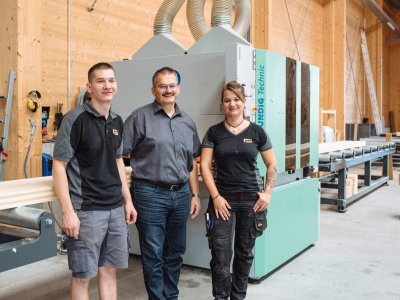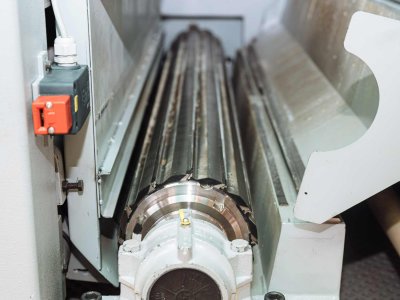Leimholz Haag: Glued Timber with Superfinish
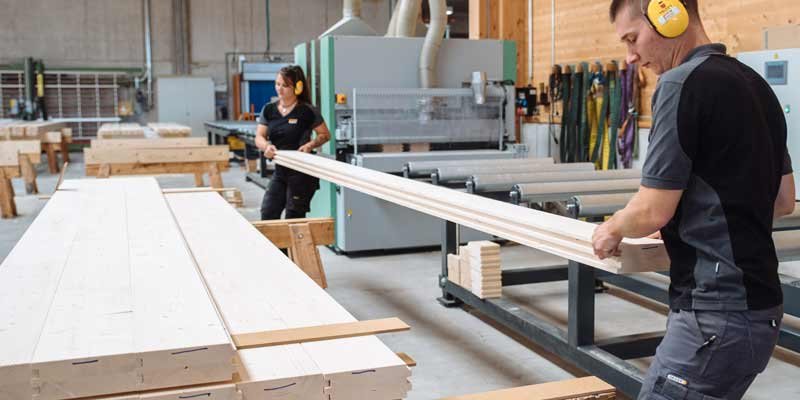 With a well thought-out concept and a lot of clout in the form of fast delivery times and high planning competence, Leimholz Haag AG in Steinach is a permanent fixture among the suppliers for Swiss timber builders. To expand his range, Peter Haag invested in a KÜNDIG Technic with planer head and texturing brush.
With a well thought-out concept and a lot of clout in the form of fast delivery times and high planning competence, Leimholz Haag AG in Steinach is a permanent fixture among the suppliers for Swiss timber builders. To expand his range, Peter Haag invested in a KÜNDIG Technic with planer head and texturing brush.
"When I founded the company in 1998, we were still among the first of our kind as an intermediate trading company for timber construction," Peter Haag remembers. That has changed in the meantime. But with its unique warehouse, an output of a good 30,000 square metres a year and the fact that Leimholz Haag also offers timber engineering, the family business - partner, son, daughter and nephew are part of the staff - in Steinach (Switzerland) still stands out from its competitors.
Before founding his company, Peter Haag himself trained as a carpenter, attended the woodworking college in Biel, as well as the management college, and managed production for 11 years at a glued timber construction company in Arbon: "I know the manufacture of the products inside out. This know-how still helps me enormously today in my work and when drawing up plans for our customers.

Clever Business Model
Two years before the turn of the millennium, he went into business for himself: "We didn't know at the beginning whether our business model would work out. Haag first had to "feel out" the combination of quick stock availability for standard dimensions and great planning competence in timber engineering in terms of marketing. But as it turns out, the strategy makes sense, because his customers often need both: "We deliver the finished elements directly to the construction site for assembly, because many simply don't have the space to process them." The carpenters then often order smaller parts from stock and cut them to size themselves. Another argument for Haag's service is its high level of expertise in engineered timber construction: "We deliver about 100 such structures a year and have experience with the largest construction elements in the industry." A large part of his 16-strong workforce deals with the planning, construction and structural engineering of these projects. Meanwhile, the preparation of the stored goods and the associated operation of his immense and globally unique fully automated high-bay warehouse requires far less manpower: "From the 604 compartments, we can call up a good 200 different standard sizes and qualities at the push of a button." Before shipping, the merchandise then only needs to be touched up and given the desired surface finish.
Sanding Machine to expand Product Range
Previously, Haag did not even have a sanding machine. With the desire to expand his product range and the knowledge that Kündig also designs machines for wood construction, he turned to the Swiss company. The requirements: In addition to fine sanded, or "super finish" as Haag calls it for some products, they also wanted to offer brushed surfaces. In addition, a planing unit was ideal for changing the standard thicknesses of the elements and thus producing intermediate sizes: "You simply have to have this flexibility today," says the likeable entrepreneur.
Practical and extremely robust
In the summer of 2018, the sanding experts from Wetzikon supplied him with just such a system in the form of the Technic-3 model. What does he appreciate most about it? The feed-return function is simple but ingenious: "With it, we no longer have to lift heavy workpieces out of the machine during several sanding passes. For example, we recently planed and fine-sanded visible ceiling panels 17 metres long, 120 cm wide and 24 cm high. Weighing about 1.5 tonnes, the parts are not exactly handy. That's where the return is worth its weight in gold." And this brings him to the robustness of the Kündig: "The fact that we can still remove 8 mm in one pass even with work piece widths exceeding 60 cm is something we usually only know from pure, heavy planing machines. We are always amazed at what the Kündig can do."
A changing Trade
And how does he experience his industry with far more than 30 years of experience? The change is extreme, says Haag. Timber construction has been booming in recent years: "Thanks to the new fire protection regulations, we are now allowed to build multi-storey buildings. Worldwide, there are already buildings with over 20 storeys." In Stockholm, an entire city district is to be rebuilt in wood, in Japan, public buildings are only being made of wood because of earthquake safety, and large construction companies are starting to buy up wood gluing companies and carpentries because they sense the trend back to the natural product. The energy policy is also pointing in this direction: "I very much welcome the development, not only because it is naturally in our favour, but also because I firmly believe that it is right," Haag is convinced.

